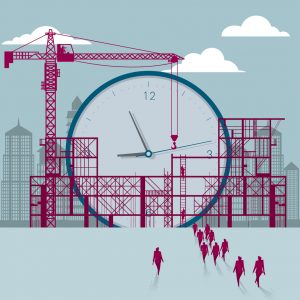Construction projects—especially those of any complexity—often experience unexpected delays, resulting in loss of use to the owner. Owners sometimes insure against this risk by getting “Soft Cost”  coverage, which covers certain cost increases resulting from project delay (think higher finance costs). Typically, though, when a construction project experiences an unanticipated delay, everyone—the owner, the builder, the subcontractors and suppliers—is interested in getting the project back on schedule. So owners sometime also get “Expense to Reduce the Amount of Loss” (ERAL) coverage, which covers the cost of accelerating the project to get it back on schedule (think higher costs for additional construction crews and overtime). But if you have both “Soft Cost” and ERAL coverage, do they cancel each other out?
coverage, which covers certain cost increases resulting from project delay (think higher finance costs). Typically, though, when a construction project experiences an unanticipated delay, everyone—the owner, the builder, the subcontractors and suppliers—is interested in getting the project back on schedule. So owners sometime also get “Expense to Reduce the Amount of Loss” (ERAL) coverage, which covers the cost of accelerating the project to get it back on schedule (think higher costs for additional construction crews and overtime). But if you have both “Soft Cost” and ERAL coverage, do they cancel each other out?
Travelers Property Casualty Company claimed that indeed they do. And, in Indianapolis Airport Authority v. Travelers Property Casualty Company of America, Travelers persuaded a trial court that because the insured was largely able to get its project back on track, it didn’t incur any covered soft cost or ERAL losses as a result. Fortunately, the U.S. Court of Appeals for the Seventh Circuit reversed that decision. The Seventh Circuit explained that Travelers’ argument reduced to “the greater the effort, the less the reward” for its insured, observing that while “parties can contract for preposterous terms” if “something silly was actually intended,” the “plain language of this insurance policy does not suggest that the parties agreed to such counter-intuitive terms as Travelers argues here.”
The facts of this case show how an issue like this can play out. The insured, plaintiff Indianapolis Airport Authority, owns and operates the Midfield Terminal, a passenger terminal that cost over $1 billion to build. During construction, two shoring towers that were being used to lift steel trusses to the roof of the terminal failed, causing a portion of the terminal’s roof structure to drop by about twelve inches. As a result of that “Shoring Tower Incident,” work on the terminal stopped temporarily. The Airport Authority incurred millions of dollars in inspection and repair costs, as well as ancillary costs traceable to the incident. Yet despite the setback, the project remained largely on schedule because the Airport Authority “took measures and incurred costs in an effort to reduce the period of delay caused by the Shoring Tower Incident, including accelerating and resequencing the work.” It submitted its claim to Travelers with a detailed breakdown of its incident-related costs, including roughly $4 million that it classified as ERAL expenses. But Travelers denied significant portions of the claim.
Under the policy’s Soft Cost Provision, Travelers had promised to pay for “soft costs” incurred during a “period of delay in completion”, which extended from the “planned completion date” to the date when the project “should be completed using reasonable speed and similar materials and workmanship.” But, because the Soft Cost coverage was subject to a 90-day deductible and the Project was actually delayed only 44 days, any covered Soft Cost losses were within the Airport Authority’s deductible and not recoverable from the insurer.
The policy’s ERAL provision was written to cover expenses incurred by the Airport Authority in reducing the amount of its Soft Cost loss. It provided that Travelers would pay the Airport Authority’s expenses during the “post-loss period of construction” if the Airport Authority incurred such expenses because of a covered loss that delayed completion beyond the planned completion date. But Travelers would pay only the “amount by which such expense reduces the ‘amount of loss’ Travelers would have otherwise paid.” In other words, the ERAL Provision paid for expenses incurred by the Airport Authority to reduce the amount of soft costs (in this case, bond interest) that Travelers would otherwise have had to pay for under the Soft Cost coverage.
Travelers argued that because, by operation of the deductible, it did not have to pay out on the Airport Authority’s Soft Cost claim at all, it had no obligations under the ERAL coverage, either. But the Seventh Circuit found that the ERAL coverage did not turn on whether Travelers actually paid out a soft cost claim but, rather, whether the Airport Authority incurred additional costs for resequencing and accelerating the project. As the court put it: “This is precisely the situation in which ERAL coverage is appropriate—where, but for additional expenses incurred by the Airport Authority, Travelers itself would have been on the hook for soft costs.” From this, the Court arrived at the only seemingly logical conclusion: “[I]n addition to direct repair costs and related inspection costs, the Airport Authority may recover its ERAL expenses, i.e., those expenses it incurred to reduce the soft costs for which Travelers would otherwise have been liable.”
So, know that you can insure against project delay and resulting mitigation costs. And know that you are likely still covered for ERAL costs even if you are early. But also know that, because such products can be novel, the insurers (and even sometimes the courts) can later misconstrue their terms to avoid the very coverage for which the policies were intended. If your insurer tries to penalize you for a job well done, you now have the Seventh Circuit’s decision to show them just how silly that position is.
 Policyholder Pulse
Policyholder Pulse


